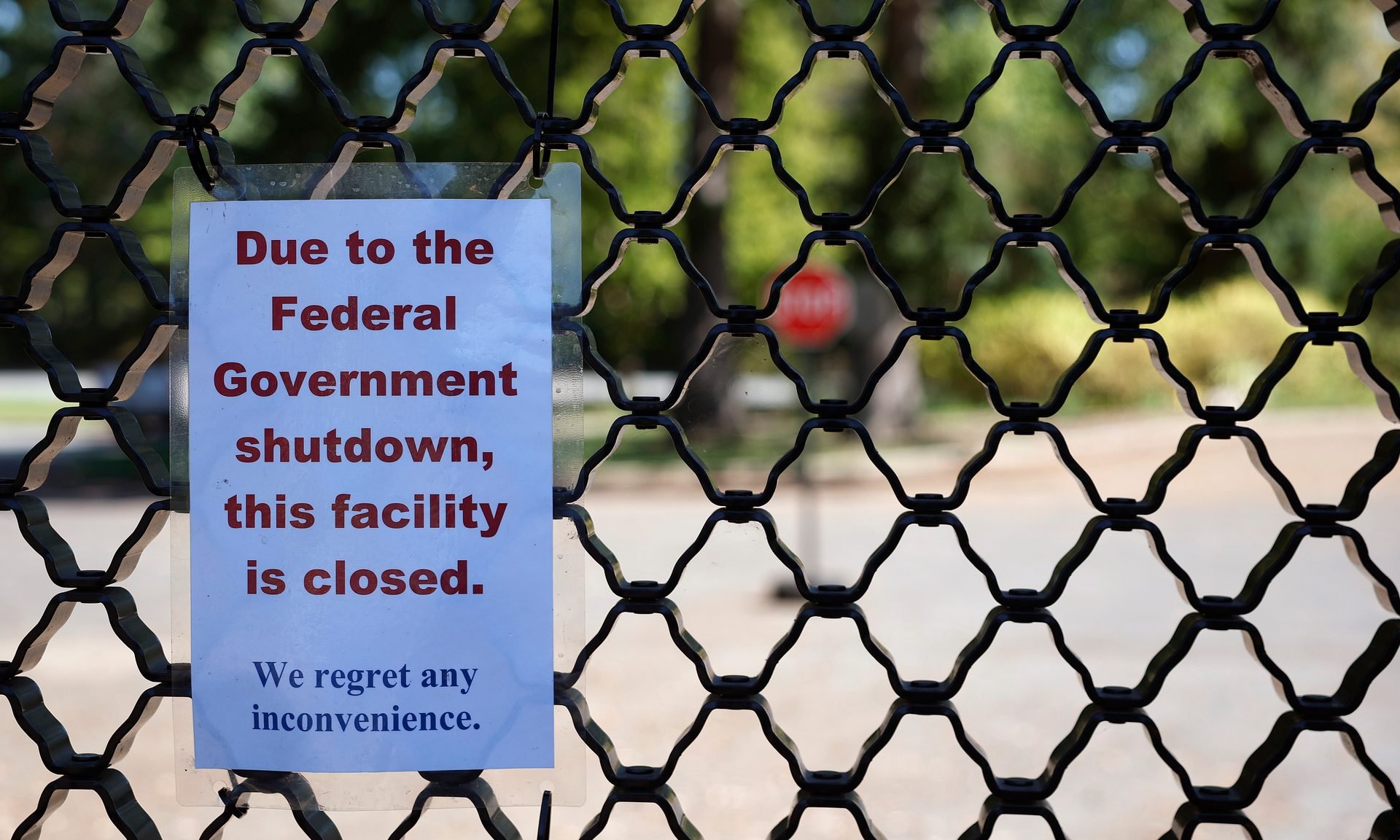How Would a Government Shutdown Affect You?
During a shutdown nonessential services will be disrupted, but most benefits won’t — at least, not initially.

Many, or all, of the products featured on this page are from our advertising partners who compensate us when you take certain actions on our website or click to take an action on their website. However, this does not influence our evaluations. Our opinions are our own. Here is a list of our partners and here's how we make money.
Updated on Nov. 13.
The longest shutdown in U.S. history — 43 days — has ended. Congress passed a package of spending measures that will keep the government running until Jan. 30, 2026, and funds some agencies and operations through September 2026.
The president signed the deal Wednesday night.
The last significant shutdown, during President Trump's first term, lasted 35 days. There have been 21 shutdowns since 1976 and most are short-lived — a few hours or days, at the most.
Congress will again face a funding milestone at the end of January 2026. Failure to pass a full budget or temporary stopgap could result in a partial shutdown.
How did we get here?
Every year, Congress approves 12 appropriations bills to keep the government funded before the new fiscal year begins on Oct. 1. For the last two years, lawmakers have avoided shutdowns by approving a series of short-term extensions. On March 14, the Senate approved a House GOP continuing resolution that extended funding for six months, keeping the government operating through Sept. 30.
When the government shuts down, it plays havoc with several federal government agencies and operations. That means nonessential services will be suspended, while other programs that receive mandatory funding will be spared. During a government shutdown, you don’t have to worry about things like air traffic control or power grid maintenance, for example.

What is a government shutdown?
The government can be forced to "shut down" when Congress fails to pass legislation to fund federal programs and agencies. This has happened 21 times since 1976. While a partial shutdown in 2018-2019 lasted 34 days, most have lasted less than a week.
When the government shuts down, many federal agencies must suspend all non-essential services. Each federal agency must develop its own contingency plan for shutdowns, which includes employee furloughs and service reductions.
For consumers, a government shutdown could result in various problems and inconveniences. But unless you work for the federal government, a government shutdown might not have an immediate impact on you.
Meet MoneyNerd, your weekly news decoder
So much news. So little time. NerdWallet's new weekly newsletter makes sense of the headlines that affect your wallet.
Overall, the brunt of the disruption falls on furloughed federal workers. The shutdown only ends when Congress can reach a funding agreement.
In the meantime, here’s how a government shutdown could impact the following:
People receiving Social Security benefits will continue to get their payments.
However, Social Security Disability Insurance (SSDI) applicants who are still waiting for a decision might have to wait longer due to possible delays at the state agencies that handle the decision-making but that are funded by the Social Security Administration.
Also, the Social Security Administration says it will pause benefits verifications, stop making corrections to earnings records and cease issuing replacement Medicare cards, among other things. But it will continue handling applications for benefits, issuing Social Security cards and tending to administrative requests such as direct deposit setups and address changes.
How does a government shutdown affect food stamps/SNAP benefits?
Delivery won’t be interrupted for benefits like the Supplemental Nutrition Assistance Program (SNAP) — once known as “food stamps” — as well as the Special Supplemental Nutrition Program for Women, Infants and Children (WIC).
Both programs have contingency funds, but if the shutdown lasts longer than 30 days, it could become difficult for the Department of Agriculture (USDA) to continue operations. WIC would shut down entirely a few days after the federal contingency fund runs out, according to the White House.
The deal that ended the 2025 shutdown extends funding for SNAP through September 2026.
» Stay informed: Check out our news hub for all the latest.
How does a government shutdown affect Medicaid and Medicare?
Delivery of both Medicaid and Medicare benefits would continue, according to the Social Security Administration’s (SSA) contingency plan.
However, some administrative functions of the programs may be suspended like:
- Receiving replacement Medicare cards.
- Benefit verifications.
- Responses to third-party information or Freedom of Information Act requests.
- Overpayments processing.
- Prisoner activities.
If needed, the SSA would increase the number of employees exempt from furlough to keep operations going, as it did during the 2013 shutdown, according to the SSA.
How does a government shutdown affect the TSA?
Transportation Security Administration (TSA) officers are considered essential federal employees and are ordered to continue working without pay during a shutdown. In the past this led to an increase in TSA agents missing work and calling in sick. Missed paychecks were a financial strain on workers — some of whom earn less than $40,000 per year.
For travelers, a shortage of TSA officers could lead to longer lines and wait times at airport security, especially if airports are forced to close some security checkpoints due to the lack of staff.
How does a government shutdown affect the U.S. Postal Service?
A government shutdown would not affect the U.S. Postal Service. Mail delivery would continue, employees would still work for their regular pay and USPS post offices would remain open.
That’s because the USPS isn’t funded by the federal government, nor does it receive tax dollars. Its revenue comes from selling products such as stamps and packaging, as well as its shipping and delivery services.
How does a government shutdown affect unemployment benefits?
Unemployment benefits will continue during a shutdown. The Department of Labor oversees the program, but unemployment compensation is administered through states. The federal government does pay administrative costs, so if the shutdown drags on, there could be a delay in processing applications.
Furloughed employees will still have access to unemployment benefits in certain states, but they may be required to return any funds they receive when the shutdown ends and they receive back pay. Those required to work without pay aren’t eligible for unemployment.
How does a government shutdown affect Amtrak?
Amtrak will likely continue to operate as usual.
Although the rail service is a federally chartered corporation, Amtrak is operated as a for-profit company. Amtrak does receive some federal grants, so a long shutdown could impact its cash flow — and perhaps even operations — but it is unlikely. In the last shutdown, train service was not impacted.
How does a government shutdown affect teachers and schools?
Public school teachers are not federal employees so they would not be furloughed under a government shutdown.
It’s also unlikely to have much impact on public school districts since most funding comes from the state and local level. The small percentage of federal funding for programs under Title I and the Individuals with Disabilities Act was provided before the start of school.
If the shutdown lasts long enough, then Impact Aid— granted to districts if their land boundaries are owned by the government — could be affected. It’s used for things like textbooks, computer equipment, advanced placement classes and teacher salaries.
How does a government shutdown affect student loans and college aid?
Plan to pay your federal student loan bill even if a shutdown happens. The repayment system is managed by servicing companies — not the government itself — so it should keep chugging along. Borrowers applying for loan forgiveness programs or consolidation could face delays because those requests go directly to the Education Department.
Federal financial aid for current students isn’t likely to be affected because students typically receive grant and loan money at the start of the semester.
A shutdown could impact borrowers who plan to attend school next year by delaying processing of the Free Application for Federal Student Aid (FAFSA).
How does a government shutdown affect air travel?
Federal Aviation Administration air traffic controllers, like TSA officers, are federal employees who are expected to continue to work without pay during a government shutdown. Some workers inevitably will not report to work without a paycheck, and even a few absences can bring the nation’s aviation system to a standstill.
During the 2019 government shutdown, the absence of 10 air traffic controllers led to a temporary grounding at New York’s LaGuardia airport, as well as delays at other major airports on the East Coast.
Air travelers will likely face more flight delays and cancellations if the shutdown drags on. Airlines have already blamed the FAA’s shortage of air traffic controllers for meltdowns earlier this year, and any absences during the government shutdown could exacerbate the issue.
A government shutdown could also delay the FAA’s hiring and training of new air traffic controllers, meaning airline reliability may not improve significantly even after the shutdown is over. (Read more on how the shutdown affects travel.)
Can I still go to national parks?
National parks and monuments typically remain open during a shutdown, manned by a skeleton crew of workers. Without a full staff, visitor services may be limited or closed. That means there may not be permitting, trash pickup, bathroom maintenance or visitor centers.
Can I still file complaints during a shutdown?
Certain Federal Trade Commission (FTC) consumer services won’t be available during a shutdown, according to its website.
- National Do Not Call Registry: You won’t be able to register your phone numbers.
- ReportFraud.ftc.gov: You won’t be able to report fraud.
- IdentityTheft.gov: You won’t be able to report identity theft.
- Econsumer.gov: You won’t be able to make international complaints.
- Bulkorder.ftc.gov (For ordering printed educational materials)
The FTC will still accept some submissions, but no action will be taken until the shutdown ends, including:
- Public Comments
- E-filing.
- FOIA requests
Meghan Coyle, Eliza Haverstock, Tina Orem and Cara Smith contributed to this article.
(Photo by Kevin Dietsch/Getty Images)
Article sources
NerdWallet writers are subject matter authorities who use primary,
trustworthy sources to inform their work, including peer-reviewed
studies, government websites, academic research and interviews with
industry experts. All content is fact-checked for accuracy, timeliness
and relevance. You can learn more about NerdWallet's high
standards for journalism by reading our
editorial guidelines.
On this page
- How did we get here?
- What is a government shutdown?
- How does a government shutdown affect Social Security payments?
- How does a government shutdown affect food stamps/SNAP benefits?
- How does a government shutdown affect Medicaid and Medicare?
- How does a government shutdown affect the TSA?
- How does a government shutdown affect the U.S. Postal Service?
- How does a government shutdown affect unemployment benefits?
- How does a government shutdown affect Amtrak?
- How does a government shutdown affect teachers and schools?
- How does a government shutdown affect student loans and college aid?
- How does a government shutdown affect air travel?
- Can I still go to national parks?
- Can I still file complaints during a shutdown?
Related articles





